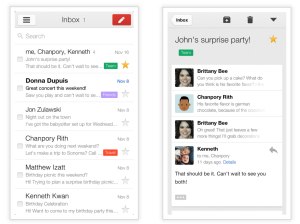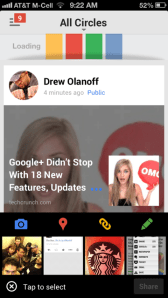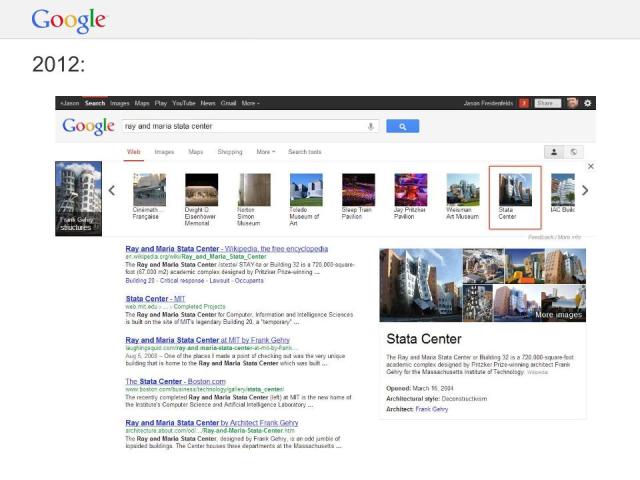As your Internet use has evolved, Google has evolved with you. And for you. Its ability to make the right decisions about what to work on and at what time is a testament to the leadership at the company. The latest wave in its evolution comes from Sergey Brin and its new CEO Larry Page, the people who started Google back in 1998.
If you’ve thought that all of Google’s products looked cobbled together, or are different from one another, it’s because they were. It was a public view into how siloed the company was as far as its product-management and design teams were concerned. Everyone worked in a vacuum, so when a new version of Google Calendar came out, it looked nothing like the user experience of, say, Gmail. While this didn’t seem like a problem for a long time, as more people used more Google products, it became clear that Google was a huge company that wasn’t in touch with its users — or each other.
What I’ve also learned while covering Google over the past two years is that it has an uncanny ability to put itself in the shoes of its users, almost to the point where they can leverage data and feedback to build, in essence, the perfect product. When I say perfect, I don’t mean flawless. I mean that when you use Google products, you’re in essence a Googler, too.
Google takes the concept of “dogfooding” to unparalleled levels, putting current and new products through such rigorous real-world testing cycles, that it’s impressive that things ever see the light of day. When you scrutinize something so much, it’s easy to scrap it because you’ve fallen out of love with it after seeing it all the time. Not Google, because it has a system in place to get feedback from both employees and outside users. The system makes the go-to-market plan a near bullet-proof approach to launching products, because there’s a good sense that it’s something that people will want to use, and use a lot.
But lately, people have noticed a bit of a change in how Google designs its products. Some of the “look and feel” has been infused in everything that Google touches these days. Whether it’s Google+ functionality, Search, Maps or YouTube, you’re starting to see a little bit of “style” come out of Mountain View. That’s not an accident, because it was Larry Page’s mandate as soon as he stepped into the Chief role.
I sat down with various members of the design team at Google, all of whom work together to make sure that its products get that similar design “touch” to delight its millions of users.
The Legacy
Google has a long history of simplistic design, and that’s because Page and Brin had never designed anything in HTML before. Additionally, there was no such thing as CSS to build off of for styling purposes. What you had was two really smart guys who had an idea that they wanted to bring to the world, so they did it the best way they could and then iterated later.
That longer view of things — knowing that they could make it better as the days, months and years went by — is Google’s strength. While most of the world, well mostly journalists, laugh at Google+ and try to pit it directly against Facebook, Google has slowly but surely turned the feature-set and social layer into something impressive.
Because Google employees are heavy Google product users, they care by default about the user experience on every level. This empathic approach to its users drives everything the company does.
That’s exactly what happened with Search. It wasn’t pretty, and then one day…it was. For the first iteration of Search, Google wanted to make everything as accessible as quickly as possible and didn’t worry about whether it was pretty or not. At that time, nobody expected things to be pretty, they just wanted to access the world’s information as quickly as possible, which is something they couldn’t really do before Google. That has changed, and so has Google.
Former Apple CEO Steve Jobs said this about customers:
Get closer than ever to your customers. So close, in fact, that you tell them what they need well before they realize it themselves. “More than Apple listening to us, it’s us who listens to Apple.”
Google has gotten so close to their customers because they are their customers, and in a way, the customers are employees because they are given wonderful services in return for their hard work. When you interact with Google Search or use Gmail, the data that goes into and out of your queries and messages are helping Google learn more about you to help you. When Google helps you, it’s able to take all of its learning in aggregate and help the rest of the world. We’re all in this together, and that is quite obvious when you observe Google very closely like I do.
The Now
 When I spoke with Google+ UX lead Fred Gilbert one of the first things he said to me was “When Larry took over he disbanded the mobile team; every team needs to be taking care of mobile.” That means that while each product team within Google is responsible for making its own product great on mobile devices, there is still a lot of cross-function work that goes into it, as you can tell by the recent Google+ iOS and Android updates, as well as Google Maps for iOS. Those two apps are arguably the most beautiful experiences that you can have on an Apple device. And it wasn’t an accident. The lead designer of Gmail, Jason Cornwell, tells me what the company’s goal was with redesigning its iOS app:
When I spoke with Google+ UX lead Fred Gilbert one of the first things he said to me was “When Larry took over he disbanded the mobile team; every team needs to be taking care of mobile.” That means that while each product team within Google is responsible for making its own product great on mobile devices, there is still a lot of cross-function work that goes into it, as you can tell by the recent Google+ iOS and Android updates, as well as Google Maps for iOS. Those two apps are arguably the most beautiful experiences that you can have on an Apple device. And it wasn’t an accident. The lead designer of Gmail, Jason Cornwell, tells me what the company’s goal was with redesigning its iOS app:
This release was all about making that great experience, making it delightful, more human and fast and responsive.
Human? Yes, Google is human, and its products are starting to feel more human, thanks to design.
This transformation isn’t completely about Larry Page, though; Gilbert discussed Eric Schmidt’s approach to things and how it has set the table for Google to dominate many verticals on many platforms:
Schmidt did an amazing job, took some land or a back yard and went in there and dug it and plowed it and put some fertilizer and seeds on it, brought the sunshine, and let it grow like crazy. Innovation was happening like a California wild garden. What Larry did, he took it another step, there are box gardens, long beds, he went in and said “OK this is what i’m going to do, you did a great job, there’s innovation everywhere, I’m going to carve out seven areas or beds, which are disciplines,” and he’s harnessed innovation and growth to build within those areas.
I also spoke with Jon Wiley, Head of Search Design, and before working on search, he actually designed the first version of Google Profile, which is now a huge part of the Google+ product. This is what happens at Google: Product elements get designed and then pop up years later in a place that you never thought it would in a product that didn’t exist when the element was built. He tells me that the reason why he likes to work at Google is that he gets to “live in a space where we can dream up the future.” How far out does Google look?
I think to a certain extent we’re thinking about the future, 3, 5, 10 years out all of the time. I want to bring the future here as fast as possible, I’m impatient. Google is impatient. We want to figure out the problems. “What problems do you have today? How can we solve that problem?” are questions that we ask each other. We like giving people back their time.
With more time, they can spend that time with their kids or family and go to the park. We think about this all of the time. In product development, we try to make as much progress as we can quickly. Launch and iterate. We have to check in with the people who use it and we have a number of ways to do that on the design side. We do a design lab where we gather user feedback, which gives us longer-term perspective.
 People by nature are impatient. Now that we have things like touch screens, access to the world’s information and constant connection with our friends, we expect it to get better and faster overnight, without thinking about the people behind the products. There are a lot of people working at Google, and in an odd way, they all have the same goals. Google just wants to make people’s lives easier. It sounds altruistic, and it is. If Google can make money with things like advertising and potentially a self-driving car, then they can continue to fund all of the little projects that you don’t get to see as a consumer on a daily basis. Those small projects could then turn into huge ones that could change your life. That’s exactly how Google has always operated, it’s just more obvious now as it becomes more transparant from the top down.
People by nature are impatient. Now that we have things like touch screens, access to the world’s information and constant connection with our friends, we expect it to get better and faster overnight, without thinking about the people behind the products. There are a lot of people working at Google, and in an odd way, they all have the same goals. Google just wants to make people’s lives easier. It sounds altruistic, and it is. If Google can make money with things like advertising and potentially a self-driving car, then they can continue to fund all of the little projects that you don’t get to see as a consumer on a daily basis. Those small projects could then turn into huge ones that could change your life. That’s exactly how Google has always operated, it’s just more obvious now as it becomes more transparant from the top down.
While it looks like Google is involved in “everything,” Wiley says that it’s very difficult to not jump into a space just because it’s cool, and focus on what matters instead:
The other thing we run into a lot with focus is there might be something that there’s a problem worth solving, but it’s not our problem to solve, not in our area of strength. We’re about large impact or scale. Not everything is well-matched to Google.
Through Google’s philosophy and approach to design, it is helping users trust them with their data more. Without your information, Google can do basically nothing for you. If you open up Google.com, the site won’t search something by itself, you have to input a string that includes what you’re interested in. Wiley went on to explain:
Design is not art, it’s fixing problems for people. I have to create things that are useful and simple. We don’t have a lot of time, things just have to work. Things need to be beautiful. If you’re going to use something, make it a part of your world and your life, you have to feel good about using it. I think that if you design in a vacuum without knowing that you’re actually solving a problem, then you’re doing your users a disservice. We’ve got millions of people using our product.
The Future
The empathy that is so obvious when you speak with these Google designers, coders and project managers is palpable. They care about how people feel when they perform a search and get a result. More importantly, when a result is displayed that actually helps a user, both sides feel as if they’ve achieved something. When I asked about this DNA trait of empathy in Google employees, Wiley explains this strength with humility, understanding that Google has a long way to go in all areas:
Google’s strength is definitely a form of empathy. Identifying real problems that actual people have. Understanding that they are problems and creatively coming up with solutions. We do this with massive amounts of computer science, engineering and good design. We’re getting better.
If you talk to people about email, it’s probably the most painful thing that any of us have to do on a daily basis. Checking email feels like work, even when it’s not. Google’s clearly trying to change that and I asked Gmail’s Cornwell about the unique problems that come up with trying to fix something that people see as so broken:
It’s a really exciting design problem, Email is this thing that’s very old. Patterns that we’re used to are old, and what a lot of people are fighting back on is this glut of information that’s coming in. Your inbox is a to-do list is that an inbox that others made for you.
A lot of what we do and continue to do is to give power back to the user and make it as pleasant a place as it can be and as human as it can be.
If Google cares, then so will we. The way we show that we care is by using the products, and Google cares by creating more of them and improving the existing ones. I asked Cornwell how Google has become so successful at keeping people on their products for years and years. ”
A lot of that is predictability and reliability. Making people feel comfortable,” he says.
There’s that word again — feel. Yes, we hear the phrase “look and feel” about design all of the time, but for Google it’s more about the feel than the look.
 In the same way that Apple makes you feel like a badass for holding an iDevice, Google empowers you to never feel stuck, lost or without connection. With its design and approach to products, Google makes you feel safe, and that’s why you should feel safe trusting them with your data.
In the same way that Apple makes you feel like a badass for holding an iDevice, Google empowers you to never feel stuck, lost or without connection. With its design and approach to products, Google makes you feel safe, and that’s why you should feel safe trusting them with your data.
As we change, Google will change. Google learns from us while we learn from its products. It’s a nice give-and-take relationship that Google has sustained since its inception. Most of us can’t understand exactly what Google does or how it does it, so the only way we can really grow our trust for what they do is to feel really good when we use their products, and that has everything to do with design. The fact that most products under Google’s massive umbrella are getting a refresh is a testament to that understanding.
We never knew what we wanted from Google, and now that we have it, we have no idea how we want it to look.


